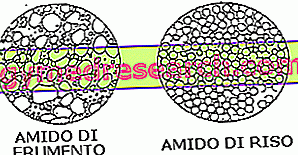Generality
The urine test, or urinalysis, is a diagnostic test that allows us to evaluate the chemical, physical and microscopic characteristics of urine .

Among the features analyzed during a urine test are: color, odor, specific weight, pH, proteins, glucose, ketones, etc.
The urine test is a painless and risk-free test.
Short revision of the kidneys
Two in number, the kidneys are the main organs of the urinary (or excretory) apparatus.
The excretory apparatus is the set of organs and anatomical structures responsible for the production and elimination of urine .
Returning to the kidneys, these reside in the abdominal cavity, on the sides of the last thoracic vertebrae and the first lumbar vertebrae; they are symmetrical and have a shape that is very reminiscent of a bean.
The most important functions of the kidneys are:
- Filter waste substances, harmful substances and foreign substances present in the blood and convert them into urine;
- Adjust the hydro-saline balance of blood;
- Adjust the acid-base balance of the blood;
- Produce the hormone erythropoietin.
What is the urine test?
The urine test, also known as urinalysis, is a diagnostic test, performed in the laboratory to analyze the chemical, physical and microscopic characteristics of an individual's urine.
The urine test includes a series of assessments that serve to detect and measure the various compounds present in a urine sample.
uses
Doctors prescribe urine testing:
- To assess the presence of a disease or infection in the urinary tract.
It is worth remembering the typical symptoms of a urinary infection: unnaturally colored urine, bad-smelling urine, pain during urination, difficulty urinating, pain in the right side or pain in the left side, blood in the urine (hematuria) and fever.
- To evaluate the efficiency of treatments for conditions such as: diabetes, kidney stones, urinary tract infections, hypertension, kidney disease or liver disease.
- To complete an accurate medical evaluation. In these situations, the urine test is a routine test and provides useful information about an individual's general health.
- Before surgery. In such circumstances, urine testing is part of pre-operative tests, such as blood tests, electrocardiograms, blood pressure measurements, etc.
- To understand the source of symptoms, such as: persistent abdominal pain, persistent back pain, blood in the urine and pain when urinating.
Parameters analyzed
A urine test includes an analysis of the physical, chemical and microscopic characteristics of the urine sample.
PHYSICAL CHARACTERISTICS
When they talk about the physical characteristics of a urine sample, doctors refer to various parameters of the liquid under examination, including:
- Color Color is a parameter that can be altered due to diet, a particular disease, a certain pharmacological intake, etc .;
- Clarity / turbidity . The clarity and turbidity of a urine sample depend on the presence of bacteria, red blood cells, spermatozoa (in humans), substances in the form of crystals, mucus, etc .;
- Odor . The smell of urine is a characteristic that can change in the presence of certain diseases, including bacterial infections and diabetes;
- Specific weight . It refers to the density of a urine sample. It is an index of the relationship between the amount of water present in the urine sample and the amount of dissolved solutes.
CHEMICAL CHARACTERISTICS
The chemical analysis of a urine sample provides information about:
- The pH .
It is the indicator of the level of acidity and the level of basicity;
- Protein concentration.
In the urine of a healthy individual, proteins are normally absent substances;
- The concentration of glucose .
Glucose is the sugar found in the blood. In the urine of a healthy person, glucose is in minimal concentrations or is missing altogether;
- The concentration of nitrite .
The presence of nitrites in the urine means that, most likely, a bacterial infection is in progress;
- The amount of leukocyte esterase .
Leukocyte esterase is an enzyme produced by leukocytes and which, as a rule, is absent in the urine.
- The concentration of ketones .
Ketones are found in the urine whenever the human body uses fats as an almost exclusive source of energy. A high amount of ketones in urine is typical of conditions such as diabetic ketoacidosis, severe vomiting or starvation.
- The presence of bilirubin .
Bilirubin is a yellow pigment, contained in bile; bile is a digestive fluid produced by the liver.
In the urine of a healthy person, bilirubin is absent.
MICROSCOPIC CHARACTERISTICS
Microscopic analysis of a urine sample provides information related to:
- The presence of crystals .
In the urine of a healthy subject, the quantity of crystals is small; large quantities, on the other hand, could indicate a urinary tract disease.
- The presence of bacteria, parasites and / or yeasts .
In the urine of a healthy individual, there are neither bacteria, nor parasites, nor yeasts;
- The presence of the so-called " casts ".
The "casts" are small clusters of red blood cells, white blood cells, fatty substances and / or proteins. Their possible finding could mean that a kidney disease is in progress;
- The presence of red blood cells and / or white blood cells .
In the urine of healthy people, red blood cells and white blood cells are absent. Their eventual finding is indicative of different conditions;
- The presence of squamous cells .
The discovery of squamous cells could mean that the urine sample collected is not pure. The presence of squamous cells is a valid reason to repeat the urine test.
Preparation
In preparation for a urine test, an individual must:
- Avoid eating foods that could alter the color of your urine. Among the main foods not recommended are blackberries, beets and rhubarb;
- Stop any pharmacological treatments based on vitamins B (in particular B2), diuretics, rifampin, phenytoin, phenazopyridine, chloroquine, levodopa, nitrofurantoin, triamterene or phenotiazian;
- Present yourself preferably on an empty stomach;
- Avoid practicing strenuous exercise before the test;
- Drink plenty of water so as to provide a sample whose urine amounts are adequate.
To find out in detail all the circumstances, the foods and the behaviors that could in some way alter the results of a urine test, it is good to contact your doctor and ask him about the less clear questions.
Procedure
The urine test is divided into two parts: the part dedicated to collecting the urine sample and the part dedicated to the analysis of the sample taken .
The part dedicated to sample collection can take place at home or in the medical-hospital center where future laboratory evaluations will be held. For the collection (and storage) of urine, the patient must use a special plastic container, provided with an airtight cap that prevents the urine from escaping.
From this description, it is quite clear that the first part is for those who must undergo urinalysis.

Unlike the previous part, this second phase is entirely up to the laboratory technicians and the doctors who have the task of analyzing and evaluating the urine sample.
MAIN METHODS OF URINE COLLECTION
The measurement of some parameters requires the collection of the urine sample to take place in a certain manner.
Thus, the ways in which urine is collected depends mainly on the purpose of the analysis.
The three most important types of collection are:
- The classic collection, for a classic urine test ;
- The collection of intermediate food, for a urine culture ;
- 24-hour urine collection, for a 24-hour urine test .
CLASSIC URINE EXAMINATION
A classic urine test is the one that takes place during a routine medical examination or before surgery.
It does not require special precautions, except for the recommendations indicated in the preparation chapter.
In general, the patient should collect the sample in the morning, shortly after waking up, because this is a time when the recommendation of the fast is certainly respected.
URINOCULTURE OR INTERMEDIATE MITTO
Urine culture is a urine test that has, as its main objective, the search for bacteria, viruses and other infectious agents in urine.
Sample collection requires the use of a sterile container and careful cleaning - of course by the patient - of the hands and genitals .
For a correct execution of the exam, it is fundamental:
- avoid collecting the first part of the urination (waste of the initial mite),
- arrange for collection in the sterile container of the next part (conservation of the intermediate mitto)
- conclude urination in the toilet (waste of the final mite).
In other words, only a central part of a urine for urine culture must be kept. This explains why we also talk about the collection of intermediate food.
What is the use of the initial motto?
The waste of the first part of the mitto serves to clean up the urethra from the previous urination.
Neglecting this recommendation could alter the outcome of the exam.
24-HOUR URINE EXAMINATION
The 24-hour urine test is a practice that has, as a final goal, the observation of how certain urine parameters vary over a whole day.
Clearly, those who undergo this test must provide to collect the product of each urination.
For a correct execution of the exam, it is fundamental:
- Bring a small container, which is used to collect every single urination, and a large container (4 liters capacity), which serves to store all 24-hour urinations;
- Avoid collecting the first daily urination;
- Mark the time of the first urination of the day. This attention will serve to know when to stop collecting urine on the next day;
- Start collecting urine from the second urination;
- Pour every single urination into the large container and keep the latter in the refrigerator, until just before going to the medical-hospital center where the analyzes will be held;
- Carry out the last urination more or less at the same time as when the first was carried out, obviously after one day.
In order not to alter the outcome of the examination, it is advisable not to touch the internal parts of the containers and not to contaminate the urine with pubic hair, faeces, toilet paper, menstrual blood and other foreign material.
Risks and complications
The urine test is a completely painless diagnostic test that is free of risks and complications.
Results
The results of a urine test are available after a few days.
The table below shows a comparison between the parameters of a normal urine test and the parameters of an abnormal urine test.
| Parameter | Normal | Abnormal |
Color | Between pale yellow and dark yellow | If your urine is colorless, it could mean that you have kidney disease or untreated diabetes. If the urine is deep yellow, it may mean that the patient being analyzed is in a state of dehydration. If the urine is red / brown, it could mean that they contain traces of blood (hematuria). Hematuria is indicative of many conditions, including: kidney stones, bladder cancer, kidney failure, nephritis, kidney cancer, urethritis, cystitis, cystinuria, prostate cancer, etc. |
Clarity / turbidity | Limpide | The turbid urine is an anomaly that may be due to the presence of pus, white blood cells, red blood cells, spermatozoa, bacteria, yeasts, crystals, mucus, parasites etc. |
Smell | Remember the smell of hazelnuts | Some foods (eg, asparagus), some vitamins and antibiotics (eg penicillin) alter the smell of urine differently. If the urine shows a sweet smell, it could mean that the patient suffers from diabetes. The presence of an urinary tract infection causes the urine to be smelly. |
Specific weight | Between 1.005 and 1.030 | If the specific gravity is higher than normal, it means that the urine is very concentrated. This situation characterizes circumstances such as excessive vomiting, excessive sweating, diarrhea or the unusual presence of glucose and protein in the urine. If the specific gravity is lower than normal, it means that the urine is very diluted. This situation characterizes conditions such as excessive fluid intake, the use of diuretics and severe kidney disease. |
pH | Between 4.6 and 8.0 | There are foods (eg citrus fruits and dairy products) and medicines (eg, antacids) that alter urinary pH. Urine with a particularly alkaline pH (therefore higher than 8) is characteristic of: excessive vomiting, kidney disease, urinary tract infections or asthma. Urine with a particularly acid pH (therefore less than 4.6) are typical of conditions, such as: severe lung disease (eg pulmonary emphysema), diabetes, aspirin overdose, episodes of severe diarrhea, a state of dehydration, alcohol starvation or abuse. |
Protein concentration | Absent | The presence of proteins in the urine may mean: kidney damage, presence of an infection, cancer, hypertension, diabetes, systemic lupus erythematosus, glomerulonephritis, heart failure (or heart failure), leukemia, poisoning (eg: mercury poisoning) or preeclampsia (in the case of a pregnant woman). |
Glucose concentration | 1.15 milligrams per deciliter (mg / dL) or 60-830 micromoles per liter (mcmol / L) in the test called 24-hour urine. | Considerable glucose concentrations in urine are typical of: diabetes, adrenal gland problems, liver damage, brain trauma, some types of poisoning and some kidney diseases. Pregnant women may have glucose in their urine, but in these situations it is quite normal. |
Ketone concentration | Absent | The presence of ketones is an anomaly that characterizes conditions such as: untreated diabetes, a low-carbohydrate diet, starvation, eating disorders (eg anorexia nervosa or bulimia), alcoholism and poisoning by isopropanol. Presence of ketones is also found in people who have not eaten for 18 hours or more. Small amounts of ketones are present in the urine of pregnant women. |
Bilirubin | Absent | The presence of bilirubin characterizes biliary tract diseases, cirrhosis, gallstones, hepatitis, liver diseases in general and liver and gall bladder tumors. |
Microscopic analysis | Absence or very low presence of red blood cells, white blood cells and "casts". Absence of bacteria, yeasts, parasites and squamous cells. Small amounts of crystals are allowed | The presence of red blood cells in the urine can be indicative of: a lesion to the kidneys or bladder, kidney stones, an urinary tract infection, glomerulonephritis, kidney cancer, bladder cancer and systemic lupus erythematosus. The presence of white blood cells in urine may mean: an infection of the urinary tract, bladder cancer, glomerulonephritis, systemic lupus erythematosus, inflammation of the vagina (in women) and inflammation of the penile prepuce (in men). The presence of "casts" in the urine is a typical characteristic of: an inflammation or damage to the renal tubules, a reduced blood supply to the kidneys, mercury poisoning, heart failure and a bacterial infection. The presence of crystals in the urine may mean: kidney stones, kidney damage or metabolism problems. Some types of crystals are due to particular infections of the urinary tract or to taking some medicines. The presence of bacteria in the urine means that a bacterial infection of the urinary tract is in progress. The presence of yeasts in the urine means that a yeast infection of the urinary tract is in progress. The presence of parasites in the urine means that a parasitic infection of the urinary tract is in progress. The presence of squamous cells in the urine means that the sample is not pure and the test must be repeated. |
WHAT CAN ALTER THE EXAM RESULTS?
The circumstances that may alter the outcome of a urine test include:
- Menstruation. For obvious reasons, this circumstance only concerns women;
- Pharmacological therapies involving the use of diuretics, erythromycin, trimethoprim or high dose of vitamin C associated with antibiotics (eg: tetracycline);
- Not having adequately preserved the urine sample or having delivered it to the laboratory with extreme delay;
- An X-ray diagnostic test with contrast medium, performed in one of the 3 days prior to the urine test.



